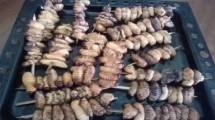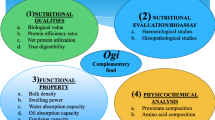Abstract
Crickets have been promoted as a possible animal protein source in child feeding by enriching porridge with cricket powder due to its nutritional contribution and affordability. The aim of this study was to develop a nutrient-dense cereal- cricket porridge suitable for school feeding programmes in Kenya and determine its safety and acceptability in comparison to cereal and cereal-milk porridges. Porridge flours containing maize and millet (MM), maize, millet and milk powder (M10) or maize, millet and cricket powder (C5) were processed by extrusion cooking based on nutritional requirements of children aged 3–5 years. Microbial and aflatoxin safety was determined using standard methods. Caregivers (n = 73) evaluated the sensory attributes of the porridges using a seven-point hedonic scale while consumer acceptability by children (n = 138) was evaluated in a randomized parallel intervention study over four weeks. The children were served 300 ml of either MM, M10 or C5 porridge during school days for four weeks. Daily porridge consumption quantities were taken with consumption of >75% of the porridge being rated highly acceptable, 50–75% moderately acceptable and < 50% least acceptable. The results showed that the developed porridge flours contributed essential macro- and micronutrients for 3–5 years old children. They were safe for human consumption with all assessed microbes being below the acceptable limits and no aflatoxins detected. M10 porridge had the most preferred colour (6.4) and taste (5.5) by the caregivers. Overall, the caregivers preferred M10 and MM, however, all the porridges including C5 registered overall acceptability scores of ≥5 (Liked very much). Among the children, acceptability of the different types of porridge increased from week 1 to 4. Based on the proportion of children who consumed >75% of the serving, acceptance of MM increased from 98% in week 1 to 100% in week 4, M10 increased from 91% to 100% while C5 increased from 55% to 70% over the same period. Only 5% of the children recorded <50% acceptance of C5 porridge in the fourth week compared to 15% at week 1. The study shows that crickets can be used to develop nutritious, porridge with considerable acceptability compared to conventionally consumed porridges. The study also shows that children can develop a liking for the less familiar food with continued exposure over time.

Similar content being viewed by others
Data Availability
Data and material used in this publication are available on request.
References
Alemu MH, Olsen SB, Vedel SE, Kinyuru JN, Pambo KO (2017) Can insects increase food security in developing countries? An analysis of Kenyan consumer preferences and demand for cricket flour buns. Food Secur 9:471–484. https://doi.org/10.1007/s12571-017-0676-0
Ayieko MA, Ogola HJ, Ayieko IA (2016) Introducing rearing crickets (gryllids) at household levels: adoption, processing and nutritional values. J Insects as Food Feed 2:203–211. https://doi.org/10.3920/JIFF2015.0080
Bawa M, Songsermpong S, Kaewtapee C, Chanput W (2020) Nutritional, sensory, and texture quality of bread and cookie enriched with house cricket (Acheta domesticus) powder. J Food Process Preserv 44:. https://doi.org/10.1111/jfpp.14601
Caparros Megido R, Haubruge E, Francis F (2017) Small-scale production of crickets and impact on rural livelihoods. In: van Huis A, Tomberlin JK (eds) Insects as food and feed: from production to consumption, 1st edn. Wageningen Academic Publisher, Netherlands
FAO/WHO (1997) Carbohydrates in human nutrition. Rome, Italy
FAO/WHO (2008) Fats and fatty acids in human in nutrition. Switzerland, Geneva
Gerrish CJ, Mennella JA (2001) Flavor variety enhances food acceptance in formula-fed infants. Am J Clin Nutr 73:1080–1085. https://doi.org/10.1177/000992280204100311
GoK (2010) National Clinical Nutrition and dietetics reference manual, 1st edn. Republic of Kenya, Ministry of Medical Services, Nairobi
Grillenberger M, Neumann CG, Murphy SP, Bwibo NO, Weiss RE, Jiang L, Hautvast JGAJ, West CE (2006) Intake of micronutrients high in animal-source foods is associated with better growth in rural Kenyan school children. Br J Nutr 95:379–390. https://doi.org/10.1079/bjn20051641
Headey D, Hirvonen K, Hoddinott J (2018) Animal sourced foods and child stunting. Am J Agric Econ 100:1302–1319. https://doi.org/10.1093/ajae/aay053
Homann AM, Ayieko MA, Konyole SO, Roos N (2017) Acceptability of biscuits containing 10% cricket (Acheta Domesticus) compared to Milk biscuits among 5-10-year-old Kenyan schoolchildren. J Insects as Food Feed 3:95–103. https://doi.org/10.3920/JIFF2016.0054
KEBS (2008) Kenya standards complementary flour specification. Kenya Bureau of Standards, Nairobi, Kenya
Kinyuru J, Kipkoech C (2018) Production and growth parameters of crickets in Kenya: experiences from a farm in a high altitude, cooler region of Kenya. J Insects as Food Feed 4:247–251
Kinyuru JN, Ndung’u NW (2020) Promoting edible insects in Kenya : historical , present and future perspectives towards establishment of a sustainable value chain. J Insects as Food Feed 6:51–58. https://doi.org/10.3920/JIFF2019.0016
Kinyuru JN, Kenji GM, Njoroge MS (2009) Process development, nutrition and sensory qualities of wheat buns enriched with edible termites (Macrotermes subhylanus) from Lake Victoria region, Kenya. Afr J Food Agric Nutr Dev 9:1739–1750. https://doi.org/10.4314/ajfand.v9i8.48411
Kinyuru JN, Kenji GM, Njoroge SM, Ayieko M (2010) Effect of processing methods on the in vitro protein digestibility and vitamin content of edible winged termite (Macrotermes subhylanus) and grasshopper (Ruspolia differens). Food Bioprocess Technol 3:778–782. https://doi.org/10.1007/s11947-009-0264-1
Kinyuru JN, Konyole SO, Kenji GM et al (2015) Nutrients , functional properties , storage stability and costing of complementary foods enriched with either termites and fish or commercial micronutrients. J Insects as Food Feed 1:1–10. https://doi.org/10.3920/JIFF2014.0011
Kipkoech C, Kinyuru J, Imathiu S, Roos N (2017) Use of house cricket to address food security in Kenya: nutrient and chitin composition of farmed crickets as influenced by age. Afr J Agric Res 12:3189–3197. https://doi.org/10.5897/ajar2017.12687
KNBS (2014) Kenya: demographic and health survey. Kenya National Bureau of Statistics (KNBS) and ICF Macro 8:1–206.
Konyole SO, Kinyuru JN, Owuor BO, Kenji GM, Onyango CA, Estambale BB, Friis H, Roos N, Owino VO (2012) Acceptability of Amaranth grain-based nutritious complementary foods with Dagaa fish (Rastrineobola argentea) and edible termites (Macrotermes subhylanus) compared to corn soy blend plus among young children/mothers dyads in Western Kenya. J Food Res 1:111–120. https://doi.org/10.5539/jfr.v1n3p111
Konyole SO, Omollo SA, Kinyuru JN, Skau JKH, Owuor BO, Estambale BB, Filteau SM, Michaelsen KF, Friis H, Roos N, Owino VO (2019) Effect of locally produced complementary foods on fat-free mass, linear growth, and iron status among Kenyan infants: a randomized controlled trial. Matern Child Nutr 15:1–12. https://doi.org/10.1111/mcn.12836
Maier A, Chabanet C, Schaal B, et al (2007) Effects of repeated exposure on acceptance of initially disliked vegetables in 7-month old infants. 18:1023–1032. https://doi.org/10.1016/j.foodqual.2007.04.005
Mennella JA, Jagnow CP, Beauchamp GK (2001) Prenatal and postnatal flavor learning by human infants. Pediatrics 107:E88. https://doi.org/10.1542/peds.107.6.e88
Michaelsen KF, Hoppe C, Roos N et al (2009) Choice of foods and ingredients for moderately malnourished children 6 months to 5 years of age. Food Nutr Bull 30:343–404
Owino VO, Sinkala M, Amadi B, Tomkins AM, Filteau SM (2007) Acceptability, storage stability and costing of α-amylase-treated maize–beans–groundnuts–bambaranuts complementary blend. J Sci Food Agric 87:1021–1029. https://doi.org/10.1002/jsfa.2799
Pambo KO, Mbeche RM, Okello JJ, Mose GN, Kinyuru JN (2018a) Intentions to consume foods from edible insects and the prospects for transforming the ubiquitous biomass into food. Agric Hum Values 35:885–898. https://doi.org/10.1007/s10460-018-9881-5
Pambo KO, Okello JJ, Mbeche RM, Kinyuru JN (2018b) Means-end chain approach explains motivations to consume insect-based foods: the case of cricket-scones in Kenya. In: Halloran A, Flore R, Vantomme P, Roos N (eds) Edible insects in sustainable food systems, 1st edn. Springer, Cham, Switzerland, pp 401–417
Walia K, Kapoor A, Farber JM (2018) Qualitative risk assessment of cricket powder to be used to treat undernutrition in infants and children in Cambodia. Food Control 92:169–182. https://doi.org/10.1016/j.foodcont.2018.04.047
WHO/FAO/UNU (2007) FAO/WHO/UNU expert consultation on protein and amino acid requirements in human nutrition. Switzerland, Geneva
Funding
The study was supported by the Danish International Development Assistance (DANIDA), Ministry of Foreign Affairs, Denmark through the GREEiNSECT project (project 13-06KU).
Author information
Authors and Affiliations
Corresponding author
Ethics declarations
Conflicts of interest/competing interests
There are was no conflict of interest.
Ethical approval
It was obtained from the Institutional Ethical Review Committee.
Consent to participate
All caregivers and their children gave written consent to participate in the study.
Consent for publication
The author consents to the publication of this paper.
Code availability
Not applicable.
Additional information
Publisher’s note
Springer Nature remains neutral with regard to jurisdictional claims in published maps and institutional affiliations.
Rights and permissions
About this article
Cite this article
Kinyuru, J., Kipkoech, C., Imathiu, S. et al. Acceptability of cereal-cricket porridge compared to cereal and cereal-milk- porridges among caregivers and nursery school children in Uasin Gishu, Kenya. Int J Trop Insect Sci 41, 2007–2013 (2021). https://doi.org/10.1007/s42690-020-00388-1
Received:
Accepted:
Published:
Issue Date:
DOI: https://doi.org/10.1007/s42690-020-00388-1




